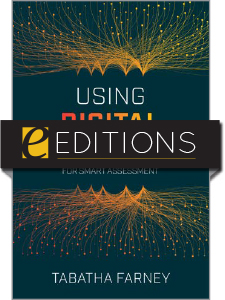
Using Digital Analytics for Smart Assessment—eEditions e-book
The download link for this product can be found on the final confirmation screen after you complete your purchase, and may also be accessed from your Account Profile. For more information about ALA eEditions file types and how to view them on eReaders, desktop computers, and other devices, see this page.
Primary tabs
You don't need to be an ALA Member to purchase from the ALA Store, but you'll be asked to create an online account/profile during checkout to proceed. This Web Account is for both Members and non-Members. Note that your ALA Member discount will be applied at the final step of the checkout process.
If you are Tax-Exempt, please verify that your account is currently set up as exempt before placing your order, as our new fulfillment center will need current documentation. Learn how to verify here.
- Description
- Table of Contents
- About the author
- Reviews
Tracking the library user's journey is no simple task in the digital world; users can often navigate through a series of different websites, including library websites, discovery tools, link resolvers, and more just to view a single journal article. Your library collects massive amounts of data related to this journey—probably more than you realize, and almost certainly more than you analyze. Too often library analytic programs simplify data into basic units of measurements that miss useful insights. Here, data expert Farney shows you how to maximize your efforts: you’ll learn how to improve your data collection, clean your data, and combine different data sources. Teaching you how to identify and analyze areas that fit your library’s priorities, this book covers
- case studies of library projects with digital analytics;
- ways to use email campaign data from MailChimp or ConstantContact;
- how to measure click-through rates from unavailable items in the catalog to the ILL module;
- getting data from search tools such as library catalogs, journal search portals, link resolvers, and digital repositories;
- using COUNTER compliant data from your electronic resources;
- techniques for using Google Tag Manager for custom metrics and dimensions;
- descriptions of analytics tools ranging from library analytics tools like Springshare’s LibInsights and Orangeboy’s Savannah to more focused web analytics tools like Google Analytics, Piwik, and Woopra; and
- data visualization tools like Tableau or Google Data Studio.
Focusing on digital analytics principles and concepts, this book walks you through the many tools available, including step-by-step examples for typical library needs.
Preface
Part I The Digital Analytics Process
Chapter 1 Understanding Digital Analytics
Chapter 2 Collecting the Data: Tools and Data Points You Should Know
Chapter 3 Analyzing Digital Data: Digital Analytics and Data Analysis Tools
Chapter 4 Digital Analytics in Practice: How Helpful Is Your Online Content?
Chapter 5 Using Digital Analytics for Collection Development
Part II Expanding the Digital Analytics Process
Chapter 6 On the Road to Learning Analytics: The University of Michigan Library’s Experience with Privacy and Library Data (Laurie Alexander, Doreen R. Bradley, and Kenneth J. Varnum)
Chapter 7 Ensuring Data Privacy in a Library Learning Analytics Database (Michael D. Doran)
Chapter 8 Creating the Library Data Dashboard (Laura Costello and Heath Martin)
Chapter 9 The Myth of the Declining Reference Statistic: Revealing Dynamic Reference Services through Digital Analytics (Marissa C. Ball and Melissa Del Castillo)
Chapter 10 Using Digital Analytics to Assess Your Social Media Marketing Efforts (Joel Tonyan)
Selected Bibliography and Further Resources
About the Contributors
Index
Tabatha Farney
Tabatha Farney is the director of web services and emerging technologies for the Kraemer Family Library at the University of Colorado Colorado Springs. She is an avid analytics enthusiast with over ten years of experience. Tabatha coauthored the 2013 LITA Guide Web Analytics Strategies for Information Professionals and has written two Library Technology Reports on configuring Google Analytics and Google Tag Manager for library-specific websites and search tools. She has presented her analytics research at national conferences and served as an analytics consultant for various library organizations. She is a co-founder and current co-chair of LITA’s Altmetrics and Digital Analytics Interest Group.
"Takes a deep approach to the value of data collection ... This title is perfect for library professionals, particularly those working in technical departments of their systems, as well as library school students who are seeking a nontraditional library career."
— VOYA
"Extremely relevant in today’s online world ... The writing only gets as technical as necessary, but the writing is careful and clear enough to be easily followed. Farney’s book is a great resource for libraries trying to better harness the wealth of data they’ve been collecting. It is also a fantastic introduction and guide for those who have perhaps been too intimidated to truly delve into the field of digital analytics."
— ARBA
"Highly recommended as a helpful resource for hands-on digital analytic and assessment techniques."
— Catholic Library World


